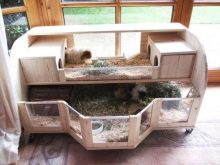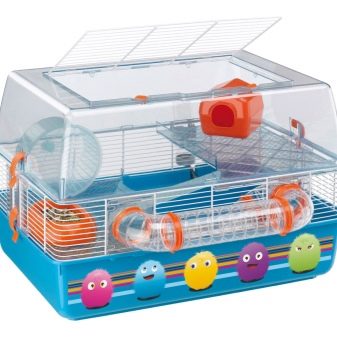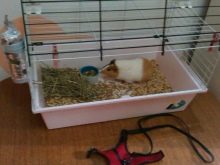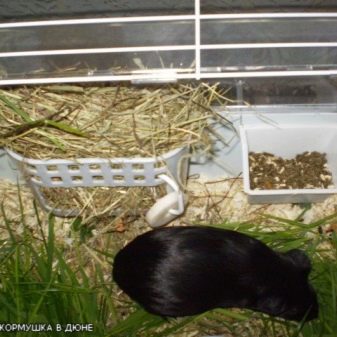Guinea pig cages: selection and arrangement

The most favorite pet is the guinea pig. This rodent is characterized by its small size and the ability to bring joy to children. Since the animal spends most of its life in a cage, before you start it in the house, you should take seriously the choice and arrangement of the furry's home, complementing it with all the necessary accessories.

Basic requirements for the cage
It is not difficult to create comfortable conditions for keeping a guinea pig, for this you just need to get her the perfect house. In order for the rodent to feel safe in it and be provided with everything necessary, the cage must meet the following requirements.
- Have a size that matches the dimensions of the animal. It also doesn't have to be cramped. Experts recommend buying medium-sized designs, even if the pet is small. The cage should have a zone not only for sleeping, but also for spending time actively. A too large structure is also not suitable for a pet, it is desirable that its area does not exceed 0.7 m2. If you plan to keep several individuals in the cage, then it is best to purchase a fairly spacious house so that there is enough space for each animal (each "resident" will need at least 1 m2). It is also important to take into account that males, unlike females, need more space, as they lead a more active lifestyle.
- Provide easy access to cleaning. In the case when an open-air cage without a roof is created for guinea pigs, there are no problems with its cleaning. As for the cages, they must necessarily have a removable top.This will make it easier to perform good cleaning and disinfection.
- Be safe for the life of the animal. It is advisable to give preference to structures made from environmentally friendly raw materials and place them in such a way that children and other pets do not pose a threat to the pig.



Varieties
Today, you can find various types of pet cages on sale, each of which differs in design, size and price. The most popular option is considered to be a lattice cage equipped with a high plastic tray. It is easy to stow away and has a wire top for good ventilation. You can additionally attach a drinker, a hammock to the rods.
The only drawback of this house is its small size.


A good option for keeping this species of rodents is also a container, which is a plastic container that resembles a terrarium. The designs of the Duna trademark have proven themselves very well, their upper part is made of transparent plastic and is attached to the pallet. Thanks to the lattice door, the house receives ventilation. The main advantages of such a cage include the absence of debris on the floor and protection of pets from drafts. In addition, the transparent walls of the structure allow you to conveniently observe the animal.
The only thing is that some models of cages do not have lattice inserts, therefore, due to the lack of ventilation, rodents can start to get sick.


Cages for guinea pigs may also differ in the material of manufacture. Consider what they are.
- Wooden. Despite the fact that wood is a natural raw material, it is able to quickly absorb odors and liquids. Therefore, wooden models are not the best option for keeping such fuzzies. In addition, animals will be able to quickly chew on the cage and render it unusable. If the owners opted for a tree, then it is recommended to cover the bottom of the structure with a tarpaulin. If desired, such a structure can be made with your own hands from wood and corrugated board.
- Metallic. This is the best type of cage because the material is durable. Pets and pest control will not damage these cages. The metal rods are mainly made of durable stainless steel, which is highly resistant to detergents.
- Plastic... They are quick and easy to clean and are not afraid of cleaning with household chemicals. The only drawback of these structures is that their walls, made of transparent material, lose their aesthetic appearance over time.



In addition, the cells differ in the type of construction, they can be either one-story or two-story, with a size of 55.5x37x64 cm.
Before choosing a particular type of cage, it is important to consider not only personal preferences, but also performance characteristics.


How to choose and where to place?
Before starting a guinea pig, you first need to purchase a cage for keeping it. Since there is a chic assortment of pet houses on the market, it will be difficult to make the right choice in favor of one model or another. When buying cages, experts recommend paying attention to the following parameters.
- The size of the structure. Guinea pigs need horizontal space and there should be plenty of it. The larger the area of the house, the freer the animal will be able to move. In cramped cages, the rodent will begin to yearn and hurt. Since, on average, at least 70 cm2 must be allocated for one pig, the best option would be to purchase a cage measuring 75x90 cm.For two individuals, therefore, a large structure will be required.
- Free access to cleaning and ventilation. Since the fluffy house should be regularly cleaned and washed, its design must have removable elements.
- Quality... All locks, doors and rods must be secure.Metal cages are a good choice for keeping guinea pigs as they are the most durable. A combined structure made of plastic and metal rods is also suitable as a comfortable home.
- The form. For pigs, rectangular designs are best; it is not recommended to buy multi-level and tall models.
- Foldable and disassembled. Prefabricated models are versatile because they are easy to store and transport.
- Distance between rods... They should be located at such a distance from each other that the animal cannot stick its head. The ideal option is 2.54x10.2 cm.
- Compliance with the design of the room... To date, manufacturers produce various models of cages that differ in color and decor.



After the cage for the rodent is purchased, there will only be a question of its arrangement and the selection of a place for installation. It should be noted right away that the position of the cage is of great importance. For example, it is not recommended to put a house in the kitchen or near it. This is due to hygiene standards. Therefore, in order to correctly locate the rodent's habitat, it is important to take into account several factors.
- The microclimate of the room. Air temperature and humidity must always remain constant. The animal feels comfortable in the temperature range from 18 to +22 degrees, while the optimal humidity level is considered to be at least 40%. Since there is often a temperature difference in rooms in winter, the cage should not be placed on the floor; a bedside table or table is suitable for it. It is also not recommended to place houses with guinea pigs near doors and windows, as a draft is possible.
- Activity. This type of animal loves to constantly be near people and requires special attention and care from the owners. Therefore, in order not to leave the pet alone, it can be settled in the living room. But in this case, it will be necessary to foresee in advance the presence of a shelter in the cage, where the rodent can hide when it gets tired.
- Noise... Guinea pigs have acute hearing, so their houses should not be placed near sources of loud sounds (TV, music center).
- Protecting your pet from other animals and children. It is advisable to place the cage in such a way that you can observe how the kids play with the pet. If there are cats and dogs in the house, the houses are best placed on a hill.



Some guinea pig owners equip their pets with housing not in the house, but on the street, under a special canopy. Such constructions should be must be protected from the penetration of predators and bad weather. If the rodent lives in an apartment, then in the summer it is recommended to take it with you to the dacha. Fresh air and an assortment of green complementary foods will give the furry a lot of pleasure and joy. In this case, the cage should be placed in a place where there is no extreme heat, dampness, cold, and there is protection from direct rays of the sun and rain.


There are also certain restrictions on the placement of cells, so they cannot be kept in the following places.
- On a windowsill on the sunny side and under a glass roof in a greenhouse. The animals will be very hot there.
- In the garage... Exhaust gases constantly accumulate in this room, which are poisonous and dangerous not only for the health of the animal, but also for humans.
- In unheated rooms... This type of pets should not be too overheated and hypothermic. It is also not allowed to warm up the room where the pig is located with kerosene gas or a kerosene lamp. These heat sources give off many harmful gases.



Arrangement
Once the pet cage is purchased, it should be well furnished. First of all, you need a litter, in this case, it is advisable to choose the filler from straw and paper (these are excellent heat insulators that will keep animals warm).It is not recommended to lay filler from pine and cedar sawdust, as they contain a lot of phenol, which is dangerous for rodents. Since pigs like to dig deep tunnels and bury themselves, then the filler layer must be at least 7 cm.
Rodents are clean and love extremely dry, clean litter, so the litter should be periodically changed to a new one, removing wet areas.


In addition, the pet's housing must be equipped with the following elements.
- Drinking bowl. It is advisable to give preference to containers made of glass and ceramics; fresh water is constantly poured into them and installed in such a way that the liquid does not spill or fall on the filler. You can also use a plastic or glass bottle as a drinker; it is hung at a certain height so that the fluffy can freely reach it. These bottles should be thoroughly brushed once a week while cleaning the cage.
- Feeder. It should be shallow and wide, as pets love to eat with their paws on its edges. No need to buy large bowls. As for the material of manufacture, the best option is ceramic containers, plastic is not recommended. Ceramic bowls last much longer and pets won't chew them.
The feeder should be placed away from the "toilet" and washed as it gets dirty, as animal excrement and filler can get into it.


Also important for guinea pigs are toys, which are most often installed in cardboard boxes or wooden cubes. Since pets love to gnaw everything, placing mineral stones in the house will also be a good solution. You cannot buy toys covered with paint in specialized stores.
If you want, you can make toys for your pet yourself from rolls of toilet paper, cardboard boxes and paper bags. In this case, it is worth paying attention to the fact that only large toys are suitable for rodents, since they can swallow small ones, which will cause suffocation.

One of the main components of the cage should be a hammock. So that the animal does not injure itself, it is important to monitor how it uses the hammock. Additionally, the structure can be equipped with a secluded corner by making a small canopy or tunnel. Animals love to hide and are often embarrassed, retiring in their hiding place. Elements for the corner can be purchased ready-made in the store, or made by hand.

Suitable for games and labyrinths. Self-made from a can of round crisps or chips, the tunnel is in no way inferior to store options. To do this, remove the sticker from the jar, all metal parts. Such labyrinths can interest the animal for a long time, which will prevent obesity in the future and have a positive effect on health.


How to choose a guinea pig cage, see the video below.








